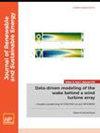Flow state analysis of molten salt in shell and tube heat exchanger with perforated baffles
IF 1.9
4区 工程技术
Q4 ENERGY & FUELS
引用次数: 0
Abstract
Addressing the issue of flow dead zones in molten salt heat exchangers in concentrating solar power generation systems, this study focuses on the conventional shell and tube heat exchanger using molten salt and heat transfer oil as the working medium. The flow dynamics of molten salt within the heat exchanger are analyzed. To quantify the volume fraction of the molten salt flow dead zones, the residence time distribution curve is employed. Four baffle salt flow configurations are comparatively assessed. Findings indicate that the four opening configurations effectively enhance the reduction of molten salt flow dead zones, with volume fraction reductions ranging from 57.8% to 68.21%. Notably, configuration 4 yields the most optimal results. Furthermore, molten salt flow states in varying regions were examined: the innermost flow dead zone exhibited the highest improvement, followed by the middle area, with the edge area showing the least enhancement. Additionally, the impact of the opening diameter on the flow dead zone was explored. The volume fraction of the molten salt flow dead zone diminishes as the opening diameter expands, with the rate of this change also decelerating. Given that molten salt at the opening manifests as a jet, enlarging the opening diameter lessens the pressure differential across the baffle, subsequently weakening the jet's intensity and its influence on the flow dead zone.带孔折流板管壳式换热器中熔盐流动状态分析
针对聚光太阳能发电系统中熔盐换热器存在的流动死区问题,以以熔盐和换热油为工质的传统管壳式换热器为研究对象。分析了熔盐在换热器内的流动动力学。为了量化熔盐流动死区的体积分数,采用了停留时间分布曲线。比较评价了四种挡板盐流形态。结果表明,4种开口形式均能有效降低熔盐流动死区,体积分数降低幅度在57.8% ~ 68.21%之间。值得注意的是,配置4产生了最优的结果。分析了不同区域的熔盐流动状态:最内流死区改善幅度最大,中间区次之,边缘区改善幅度最小。此外,还探讨了开孔直径对流动死区的影响。熔盐流动死区的体积分数随着开口直径的增大而减小,且变化速率也在减小。考虑到开口处的熔盐表现为射流,增大开口直径减小了隔板上的压差,从而减弱了射流的强度及其对流动死区的影响。
本文章由计算机程序翻译,如有差异,请以英文原文为准。
求助全文
约1分钟内获得全文
求助全文
来源期刊

Journal of Renewable and Sustainable Energy
ENERGY & FUELS-ENERGY & FUELS
CiteScore
4.30
自引率
12.00%
发文量
122
审稿时长
4.2 months
期刊介绍:
The Journal of Renewable and Sustainable Energy (JRSE) is an interdisciplinary, peer-reviewed journal covering all areas of renewable and sustainable energy relevant to the physical science and engineering communities. The interdisciplinary approach of the publication ensures that the editors draw from researchers worldwide in a diverse range of fields.
Topics covered include:
Renewable energy economics and policy
Renewable energy resource assessment
Solar energy: photovoltaics, solar thermal energy, solar energy for fuels
Wind energy: wind farms, rotors and blades, on- and offshore wind conditions, aerodynamics, fluid dynamics
Bioenergy: biofuels, biomass conversion, artificial photosynthesis
Distributed energy generation: rooftop PV, distributed fuel cells, distributed wind, micro-hydrogen power generation
Power distribution & systems modeling: power electronics and controls, smart grid
Energy efficient buildings: smart windows, PV, wind, power management
Energy conversion: flexoelectric, piezoelectric, thermoelectric, other technologies
Energy storage: batteries, supercapacitors, hydrogen storage, other fuels
Fuel cells: proton exchange membrane cells, solid oxide cells, hybrid fuel cells, other
Marine and hydroelectric energy: dams, tides, waves, other
Transportation: alternative vehicle technologies, plug-in technologies, other
Geothermal energy
 求助内容:
求助内容: 应助结果提醒方式:
应助结果提醒方式:


